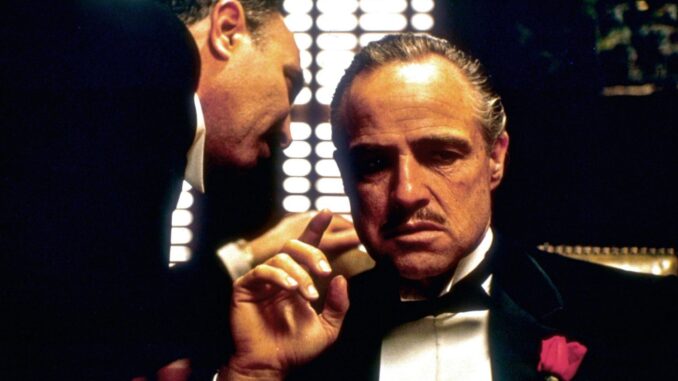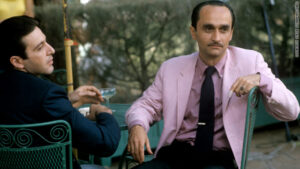
John Cazale Was the Broken Heart of The Godfather

He slaps Al Pacino on the back of the head and then drops into frame, sly and drunk, teetering so close to Diane Keaton that all she can do is laugh and lean away. That’s how John Cazale enters The Godfather, in a simple scene—Michael Corleone (Pacino) introducing his girlfriend, Kay (Keaton), to his older brother Fredo (Cazale) at a wedding—that turns into a joyride.
There’s an off-kilter quality to it: the way Pacino jumps, clearly surprised at Cazale’s slap, and the way Keaton nervously beams and glances over at Pacino as Cazale softly murmurs a greeting, playing Fredo’s drunkenness with a quiet, swaying charm. He takes his time, holding the center of the scene as Pacino and Keaton sit in thrall to his performance. The moment is suffused with a kind of electricity. Here were two of the soon-to-be biggest actors of Cazale’s generation, disarmed in a matter of seconds.
This was the magic of the late Cazale, whose mythic career has been defined by his performance as the heartbreakingly inept Fredo in Francis Ford Coppola’s gangster epic, which turns 50 this month. The lore of the film is well known—Coppola apparently had a miserable time directing it, but still managed to helm an instant classic. The movie established him as an auteur, reinvigorated Marlon Brando’s career, and turned Pacino from an unknown theater actor into a major movie star.
But Cazale’s presence in the movie has only grown richer over time. Though actors have always appreciated him, everyone else is finally catching up. As Pacino declared in a recent interview with The New York Times, Cazale, was “one of the great actors of our time—that time, any time.”
“He was this weird little asterisk in terms of film history,” said Richard Shepard, the director of the Cazale documentary I Knew It Was You, in a 2010 interview with the Los Angeles Times. The actor starred in just five films—The Godfather, The Conversation, The Godfather Part II, Dog Day Afternoon, and The Deer Hunter—all classics, all nominated for best-picture Oscars.
Yet at the time, Cazale wasn’t regarded as a screen Zelig whose cool presence and acting style captured the spirit of the decade. Rather, he was a stage actor who played character roles on film, mostly in works by his friend Coppola and alongside his friend Pacino, with whom he came up in the New York theater scene in the 1960s. That’s how casting director Fred Roos first saw him, at an off-Broadway show starring Richard Dreyfuss. Roos, who was casting The Godfather at the time, was there to see Dreyfuss, but came away with a new discovery in Cazale, instantly aware that he had found his Fredo.
And what a Fredo he was. His face alone was striking—the dark, heavy brow, the wavy moon of his hairline, the exhausted eyes. Cazale’s face cast a constant shadow over itself, a brooding canvas for Gordon Willis’s inky cinematography.
Though he charms at the outset, it’s quickly established that Fredo is the throwaway among his brothers. He is constantly at fumbling, anxious odds with Michael’s coldness and Sonny’s confidence. He is the most inept, unable to cultivate a sense of business savvy. His first major act in the film is one of failure: dropping his gun when his father is shot in the street, then wailing over his body when he’s perceived as being dead. “I empathized a little bit with Fredo,” Coppola says in the film’s commentary, digging into the character’s psychology. “He bungled guarding his father…[but] he loved his father no less than the other brothers. He must feel so responsible for what happens.”
As the film progresses, Fredo lets that failure drive him into uselessness. He watches his little brother become his father’s successor, as the others rise to support Michael. Fredo is eventually flung over to Las Vegas where he can feel important while far, far out of his family’s way.
Cazale is only in the first Godfather for a matter of minutes, but his performance lays the groundwork for Fredo’s tragic, consequential arc in The Godfather II. He makes excellent use of his extended screen time, playing Fredo with an enlivened air that gets deflated after Michael finds out that Fredo has betrayed him. In the now famous kiss-of-death scene, Cazale struggles to get out of Michael’s grasp, a fearful expression on his face. Without a word, he communicates layers of terror. His biggest scene arrives soon after, when he and Michael meet in Las Vegas so Michael can tell Fredo the exact terms of his excommunication. The staging is heavy-handed, but lyrical: Michael stands by the window as Fredo lays back in a reclining chair, beneath him. Fredo protests and airs his frustrations, revealing he knows how little his family thinks of him. “I’m your older brother, Mike, and I was stepped over!” Fredo exclaims. “I can handle things! I’m smart! Not like everybody says! Like dumb! I’m smart, and I want respect!”
Cazale delivers the entire scene from the chair, flailing like a fish above water. Dying, but not yet dead. He’s physically and metaphorically situated below Pacino, who looks down at Fredo like a funeral guest gazing upon the body. Another actor draped over that chair—a bouncy, unruly scene partner—might have been daunted, their capability hampered by the limitations of the set design. Cazale, however, makes it an inextricable part of his performance. When he’s done with his ranting and raving, he just lies there, flat and exhausted, his face a picture of defeat.
“The chair made him so limp and springy,” Coppola says in the film’s commentary, noting that he was influenced by the blocking he did in The Conversation, another film starring Cazale. “It worked great. Sometimes you get lucky with a chair, I guess.”
It is, of course, Cazale’s performance that makes the scene a memorable one. He harnesses Fredo’s inner hurt to give the character shades of sympathy, however strained they may be. “John felt very strongly that finding the character, you had to find the pain first,” theater producer Robyn Goodman said in the Cazale documentary.
“He was maniacal about the work,” added Meryl Streep, who costarred with Cazale in The Deer Hunter and was his girlfriend from 1976 until his death from cancer in 1978. “I was more glib and ready to pick the first idea that came to me. And he would say, ‘There’s a lot of other possibilities…’”
Cazale would prove his range in his latter films, leaning into roles that trended toward tragedy. What they all shared was his depth of presence and his curious choices, rendering his moments onscreen with a strange spark. “John was there. He occupied space,” Pacino once said, trying to explain his friend’s inexplicable talent. The Godfather was the film that started it all, dropping Cazale into the center of the frame and letting him do the rest.
